史努比乘阿尔忒弥斯1号前往太空
Snoopy, the zero-gravity indicator for NASA’s Artemis I flight test, floats in space on Nov. 20, 2022, while attached to his tether in the Orion spacecraft. In this enhanced image, Snoopy stands out in a custom orange spacesuit, while Orion’s interior has been shaded black and white for contrast. The character’s spacesuit is modeled after the suit astronauts will wear during launch and reentry in Orion on future missions to the Moon. NASA has shared an association with Charles M. Schulz and Snoopy since the Apollo missions and the relationship continues under Artemis. Snoopy was selected as the zero-gravity indicator for the flight because of the inspiration and excitement the character has provided for human spaceflight for more than 50 years. Image Credit: NASA 2022年11月20日,NASA阿尔忒弥斯一号飞行测试的零重力指示器史努比被系在猎户座飞船的缆绳上漂浮在太空中。在这张增强的照片中,史努比穿着定制的橙色宇航服,而猎户座的内部则采用了黑白对比色。该角色的宇航服是仿照宇航员在未来登月任务中发射和返回猎户座时穿的宇航服。自从阿波罗任务开始,NASA就与查尔斯·M·舒尔茨和史努比一直保持着合作关系,在阿尔忒弥斯的领导下,这种关系还在继续。史努比被选为这次飞行的零重力指示器,是因为这个角色在50多年来为人类太空飞行提供了灵感和刺激。…










